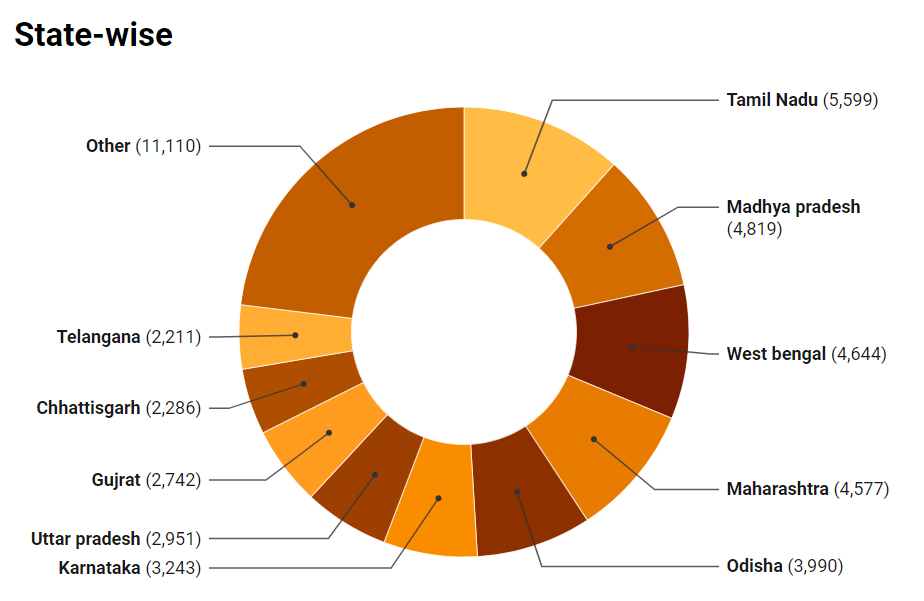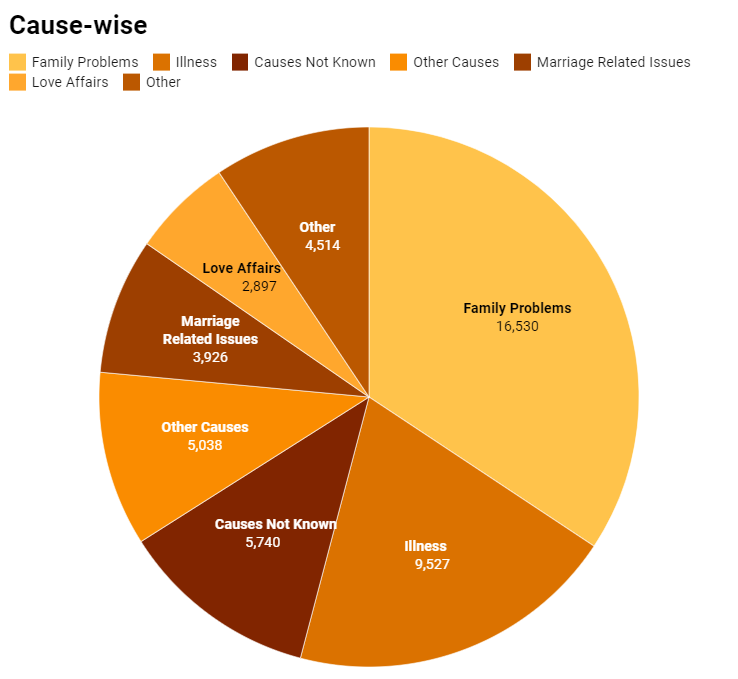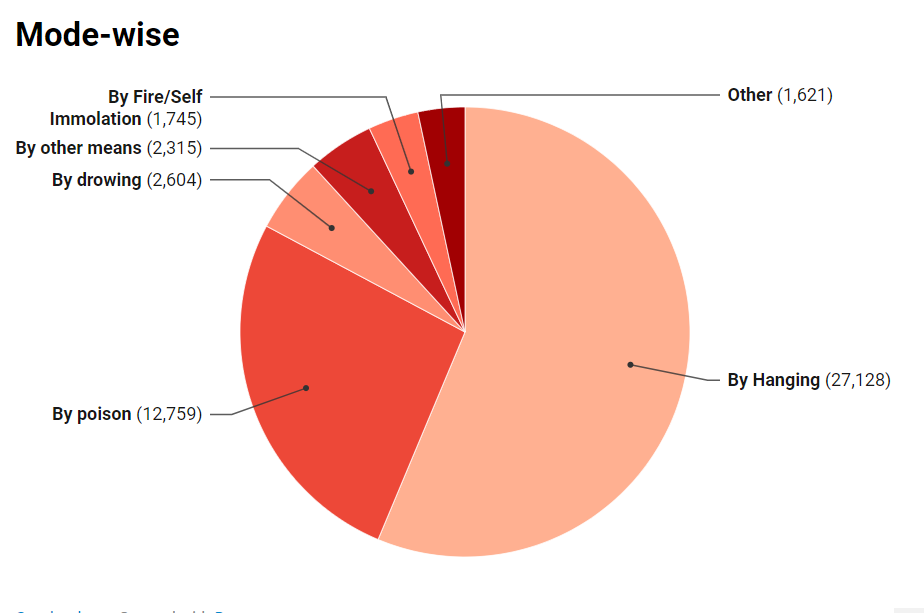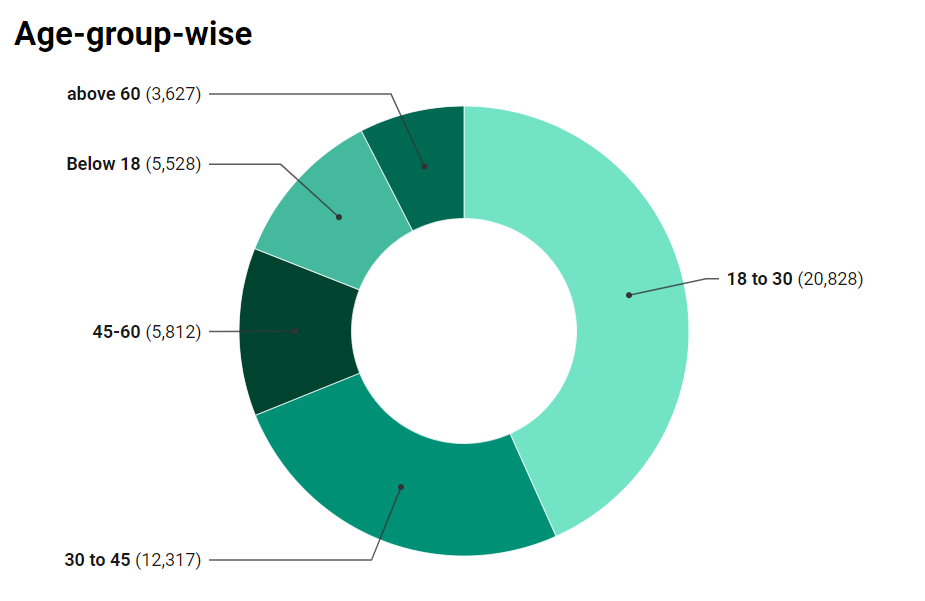Introduction
Female suicides in India is a deeply concerning issue that demands attention. While mental health is a global challenge, the factors contributing to female suicides in India are shaped by the country’s unique social, economic, and cultural landscape. Drawing on data from official government sources, this blog will delve into key patterns and trends in female suicides across the nation. We will explore geographic variations, age-related vulnerabilities, underlying causes, and the methods most frequently adopted. By analyzing these elements, we aim to better understand the complex factors at play and how they contribute to the rising suicide rates among women.
In this first part of our two-blog series, we focus on the geographic distribution, age-group patterns, causes, and means of suicide. Stay tuned for the second part, where we’ll explore the impact of education, marital status, profession, and income on female suicide rates. Together, these insights can help frame more effective interventions and support mechanisms.
Table of Contents
1. Female Suicides: Geographical Triggers & Patterns
The prevalence of female suicides varies widely across the globe, deeply influenced by cultural, economic, and social factors. Notably, three of the largest developing nations—India, China, and Russia—report some of the highest female suicide rates. This is driven by a combination of societal pressures, pervasive social stigmas, and limited access to mental health resources. According to the Accidental Deaths & Suicides in India 2022 report by the National Crime Records Bureau and the Ministry of Home Affairs, the data paints a particularly alarming picture for India, revealing the urgent need for focused interventions.

1. States with Highest Number of Suicides:
- Tamil Nadu: Leads with 5,599 cases, accounting for the highest number of female suicides.
- Madhya Pradesh, West Bengal, Maharashtra, Odisha: These states also report high suicide rates, with figures above 3,900 cases each.
- Combined, these top five states contribute significantly 50% to the national total, indicating possible socio-economic and mental health challenges in these regions.
2. States with Moderate Numbers (2,000 – 3,000):
- Karnataka, Uttar Pradesh, Gujarat: Each of these states reports between 2,700 and 3,200 cases.
- Telangana and Andhra Pradesh are similarly high, which suggests that South India has a higher prevalence of female suicides compared to the northern regions.
- These regions may require targeted mental health awareness and prevention programs.
3. States with Low Incidence (Below 1,000):
- Assam, Haryana, Jharkhand, Punjab: Reported between 500 and 1,000 cases.
- Smaller states and UTs such as Tripura, Himachal Pradesh, Goa, Sikkim have figures below 500.
- Union Territories (UTs): Smaller UTs like Delhi (859 cases), Jammu & Kashmir (138 cases), Puducherry (123 cases) also show varying incidence rates.
4. States/UTs with Very Low Cases (Below 100):
- Goa (70), Sikkim (67), Meghalaya (49), Chandigarh (40): These regions report notably fewer cases of female suicides.
- Northeastern States: States like Arunachal Pradesh, Nagaland, Manipur, Mizoram, and others have fewer than 50 cases, with Ladakh reporting only 1 case and Lakshadweep reporting none.
5. Observations by Region:
- Southern States: Tamil Nadu, Karnataka, Telangana, and Andhra Pradesh account for a large portion of the suicide numbers. This could reflect factors like social pressures, economic challenges, or mental health issues specific to this region.
- Central and Western India: States like Madhya Pradesh, Maharashtra, and Gujarat also report a substantial number of suicides, suggesting a broader socio-economic challenge across both regions.
- Northern and Northeastern India: Generally, these regions report lower numbers, but some states like Uttar Pradesh and West Bengal remain exceptions with higher figures.
2. Causes of Suicide Among Females

The data provides insights into the causes of suicides, specifically focused on the number of cases attributed to different reasons. Below is a detailed analysis:
1. Dominant Causes of Suicides:
- Family Problems (16,530 cases): This is by far the leading cause, accounting for a significant portion of all suicides. It highlights the critical impact of familial stress and conflicts on mental health.
- Illness (9,527 cases): Health issues, both physical and mental, are the second leading cause, underscoring the link between chronic illness and mental health struggles.
- Causes Not Known (5,740 cases): The large number of unspecified causes indicates a need for better reporting and investigation into the reasons behind suicides.
2. Health-Related Factors:
- Other Prolonged Illness (4,696 cases): Chronic illness is a major factor contributing to suicides, which aligns with the finding that physical health challenges can lead to mental health deterioration.
- Insanity/Mental Illness (4,234 cases): Mental health issues, such as depression and other psychiatric disorders, are significant contributors.
- Cancer (342 cases) and Paralysis (214 cases): These specific health conditions also lead to a notable number of suicides, likely due to the pain and long-term suffering associated with such diseases.
- AIDS/STD (41 cases): Though the numbers are smaller, they represent the stigmatization and social isolation faced by those with these conditions.
3. Marriage and Relationship-Related Factors:
- Marriage Related Issues (3,926 cases): Problems within marriages, including conflict and dissatisfaction, account for a significant portion of suicides.
- Love Affairs (2,897 cases): Romantic relationships are another major cause, especially among younger individuals.
- Dowry Related Issues (1,561 cases) and Non-Settlement of Marriage (992 cases): Cultural practices and societal expectations around marriage are important drivers.
- Extra-Marital Affairs (545 cases): This highlights the emotional and societal pressures related to infidelity.
- Divorce (197 cases): While fewer in number, divorce also remains a contributing factor.
4. Academic and Career Stress:
- Failure in Examination (958 cases): Academic pressure is a key factor, especially among students and young adults, leading to severe mental health crises.
- Professional/Career Problems (278 cases): Stress related to jobs and career instability also leads to suicide.
5. Socioeconomic Challenges:
- Bankruptcy or Indebtedness (617 cases): Financial struggles and debt are significant contributors, especially in lower-income communities.
- Unemployment (334 cases): Joblessness and lack of financial security are known to worsen mental health issues.
- Poverty (203 cases): Economic hardship plays a significant role in driving individuals to extreme measures.
- Property Disputes (363 cases): Disputes related to property ownership and inheritance also lead to suicide in some cases.
6. Social Pressures:
- Fall in Social Reputation (225 cases): The fear of losing social standing or facing public disgrace is a factor, especially in conservative communities.
- Suspected/Illicit Relation (274 cases): Social judgment and suspicions related to relationships can lead to severe distress.
- Illegitimate Pregnancy (30 cases): Social stigma and shame around pregnancy out of wedlock remain an issue, although the numbers are lower.
7. Other Causes:
- Drug Abuse/Alcoholic Addiction (239 cases): Substance abuse and addiction also play a significant role in suicides, reflecting the dual impact of mental health and addiction issues.
- Physical Abuse (Rape, etc.) (27 cases): While fewer in number, the impact of sexual violence on mental health and suicide rates is clear.
- Ideological Causes/Hero Worshipping (59 cases): A small number of cases are linked to extreme ideological beliefs or obsessive worship of individuals, which can lead to disillusionment and suicidal tendencies.
Key Insights:
- Family and Relationship Conflicts: The leading cause of suicide, this emphasizes the importance of mental health support systems and conflict resolution in families and relationships.
- Health and Illness: Chronic and mental health conditions contribute heavily to suicide rates, showing a need for better healthcare, especially for mental health services.
- Financial Stress: Bankruptcy, unemployment, and poverty are significant causes, suggesting the need for stronger financial support systems and economic interventions.
- Social and Cultural Pressures: Marriage-related issues, societal reputation, and academic pressures are major stressors in certain communities, requiring both societal change and individual-level support mechanisms.
3. Methods of Suicide: A Statistical Breakdown of Common Modes and Their Prevalence

1. By Hanging
- Hanging is the most common mode of suicide, accounting for nearly half of the cases. It is the predominant method likely due to accessibility and the immediate, irreversible nature of the act.
2. By Poison
- Poisoning is the second most common method, accounting for about 23% of the cases. This method might be chosen due to the availability of poisonous substances, such as pesticides or household chemicals.
3. By Drowning
- Drowning is a less common method, accounting for around 4.7% of cases. It may be chosen in regions where large water bodies are accessible.
4. By Other Means
- This category includes any other methods not specifically listed. It may represent a range of diverse approaches.
5. By Fire/Self-Immolation
- Self-immolation is a particularly painful and dramatic method, accounting for 3.2% of cases. This method could reflect extreme desperation or protest in some cases.
6. By Coming Under Running Vehicles/Train
- A relatively small percentage, this method is often fatal but less common due to the specific circumstances required.
7. By Jumping
- Jumping from heights (e.g., buildings or bridges) accounts for less than 1% of the cases. It is likely used when tall structures are accessible.
8. By Consuming Sleeping Pills
- Though this method may appear peaceful, it accounts for a relatively small portion of the cases, suggesting it may not always be fatal without the use of extreme quantities.
9. By Self-Inflicting Injury
- Direct self-harm through injury is rare but still contributes to a small percentage of suicides.
10. By Touching Electric Wire
- Suicide by electrocution is extremely rare, perhaps due to the challenge of access to high-voltage sources.
11. By Firearms
- Firearms are the least used method in this data, likely due to restrictive access to guns in many regions.
Key Insights:
- The two most common methods, hanging and poisoning, account for nearly 72.5% of all suicide cases, highlighting the impact of accessibility and immediacy in choosing a method.
- More extreme or violent methods like self-immolation, jumping, or self-inflicted injuries are significantly less common.
- The use of firearms is rare, which may be attributed to the availability of weapons in the region.
4. Age-Specific Trends in Female Suicide: Analyzing Key Risk Factors Across Life Stages

1. Highest Suicide Rate Among 18 to 30 Age Group
The 18 to 30 age group has the highest count, with 20,828 cases, making up a significant portion of the total female suicides.
Key contributing factors for this age group may include:
- Relationship and marital issues: Women in this age range often experience relationship challenges, marriage pressures, dowry issues, and domestic violence, all of which can lead to emotional distress.
- Career and education pressure: The stress of career development, academic performance, and employment challenges can contribute to feelings of failure or inadequacy.
- Social and familial expectations: Women in this age group are often under pressure from family and society to conform to traditional roles, which can lead to mental health struggles if their personal aspirations are at odds with these expectations.
- Love affairs: Young women may experience emotional turmoil from failed relationships or unreciprocated love, leading to vulnerability.
2. 30 to 45 Age Group
The second-highest number of suicides is in the 30 to 45 age group, with 12,317 cases.
Key factors include:
- Family and marital responsibilities: Women in this age range are often managing multiple responsibilities, including childcare, household duties, and professional work, which can lead to overwhelming stress.
- Domestic violence and abuse: This age group might be more susceptible to ongoing domestic violence or marital problems, further leading to mental health challenges.
- Career stagnation: Women in this age group may face career stagnation or struggle with work-life balance, causing frustration or financial strain.
- Health issues: Early onset of health problems like hormonal imbalances, mental illness, and stress-related disorders may also contribute to suicide risk.
3. Significant Drop in Suicide Rates in the 45-60 Age Group
The 45-60 age group shows a significant drop in suicide cases, with 5,812 cases.
Key factors:
- Menopause and hormonal changes: Hormonal fluctuations during menopause can lead to depression, anxiety, and mood swings, contributing to emotional instability.
- Emptiness syndrome and loneliness: With children leaving home and societal expectations shifting, women may experience loneliness, a loss of identity, or purpose.
- Health concerns: Chronic health issues such as diabetes, arthritis, and heart conditions may add physical and emotional stress.
4. Below 18 Age Group
Suicides among girls under 18 account for 5,528 cases.
Key factors include:
- Academic pressure and exam failure: This group is vulnerable to the intense academic pressure to perform well in exams, which can lead to stress, anxiety, and feelings of worthlessness.
- Family expectations and societal norms: Cultural and family expectations around behavior, dress, and future roles can create emotional strain.
- Peer pressure and bullying: Adolescents may face bullying or social rejection, both online and offline, contributing to mental health issues.
- Relationship problems: Young girls might experience distress from unrequited love or relationship problems.
5. Above 60 Age Group
The elderly age group (above 60) has the lowest suicide rate with 3,627 cases.
Key factors:
- Loneliness and isolation: Many elderly women may experience isolation due to the death of a spouse, children moving away, or a shrinking social circle.
- Health problems: Chronic illnesses, mobility issues, and age-related diseases can lead to depression or feelings of helplessness.
- Financial dependence: Older women might face financial insecurity, especially if they are dependent on family or have no pension or savings.
- Loss of independence: Physical limitations and dependence on others for daily activities can lead to feelings of frustration and worthlessness.
Key Insights:
- Women aged 18 to 30 are the most vulnerable group to suicide, with relationship issues, family expectations, and career pressure as major stressors.
- Women aged 30 to 45 also face significant stress, particularly from family responsibilities, career stagnation, and health problems.
- Suicide rates decline in older women (45-60 and above 60), but these groups still face challenges such as loneliness, health concerns, and financial insecurity.
- Adolescents (below 18) are particularly vulnerable to academic stress, family pressure, and social issues, showing the need for mental health support for young girls.
Potential Interventions:
- Mental health counseling and support for young women facing relationship, career, or societal pressures.
- Support systems for middle-aged women dealing with family responsibilities, domestic abuse, or health issues.
- Elderly care programs to address loneliness, health, and financial dependence among older women.
- Stress management and mental health education for adolescents to cope with academic pressure and peer-related challenges.
Conclusion
As we’ve seen, female suicides in India are influenced by a range of factors, including regional differences, age-specific vulnerabilities, and societal pressures. The methods of suicide also shed light on the accessibility of certain means, pointing to the importance of targeted prevention strategies. While this blog has provided a broad overview of where and how these tragedies occur, the picture is incomplete without considering personal circumstances such as education, marital status, and financial stability.
In the next part of this series, we will delve into these individual factors, examining how women’s education, professional life, marital status, and income levels contribute to suicide rates. Understanding these aspects will provide a fuller picture of the challenges Indian women face and the urgent need for comprehensive mental health support.
